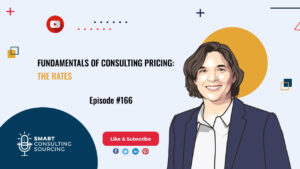Hello and welcome to the episode 32 of our podcast: Smart Consulting Sourcing, THE podcast about Consulting Procurement.
My name is Hélène, and I’ll be your host today.
Each week I’ll give you the keys to better use, manage and source consulting services. This week, I’ll discuss how to Anticipate your consulting needs to start building relationships and intimacy with your providers
Last week, I explained Why should Finance and Strategy get involved in decision-making on large consulting projects.
Independent of whether you implement strict Demand Management or just filter projects based on the costs, you need to look closely at the most expensive projects to ensure they are strategic and timely.
For that purpose, you will need to have Strategy and Finance involved in the decision. Embarking on them early in the process will help keep the deadlines and smooth the validation.
Anticipation is a key skill for procurement executives.
That is what separates strategic thinkers from tactical executants. If your objective is to create more value for your Company through your procurement work, now is the right time to start honing your anticipation skills.
In Procurement, the anticipation of the need comes from the ability to listen to your internal clients and translate their needs into a list of potential suppliers. It comes from the fact that 80% of your recurring needs are usually covered by 20% of your Suppliers.
You can anticipate what Suppliers will be used, when and how, by looking at both your past Expenses and the Strategy for the years to come.
But the needs can evolve over time and, to always have the right picture in mind, you should organize regular checkpoints with your internal clients. Depending on the nature of the needs, strategic, recurring, or spot, the nature of the relationships you build with the suppliers will differ.
Start with your strategic consulting needs
The principles for segmenting the entire supply base for Consulting Services should be the same for other categories.
Often companies will choose the largest projects as strategic needs because they capture most of their spend. But the spend should not be the only criterion.
There are several ways to define a strategic need:
- A unique strategic skill,
- A project with a significant impact on your organization,
- An essential task in your strategic roadmap.
The intimacy between a Consulting Firm and its clients can facilitate and accelerate projects. When you regularly work with Consultants, they become “plug-and-play”: they know your industry, your organization, and your culture.
You should plan regular meetings with your Strategic Suppliers to keep them in the loop and exchange about their Performance Assessments results.
Regroup your recurring needs
When looking at your Strategy and the challenges you are facing in the next 3 to 5 years, you can already identify some recurring, long-term, and well-defined needs for consulting services.
They can be either:
- Medium-sized projects designed with a repeat model.
- Small or mid-sized projects with similar scopes and methodologies. They can be performed by the same or different consultancies.
Recurring and duplicate projects are good candidates for strategic management and should not be treated as the tail. You can integrate the suppliers in your List of Preferred Suppliers and build a frame contract to define the term and negotiate on volumes.
That’s typically the right to start leveraging 2nd and 3rd Tier Consulting Firms (small to mid-sized) to decrease the average costs and cover your business lines’ niche and/or operational needs.
Just like your Strategic Suppliers, you should have regular meetings with your recurring providers.
Be particularly vigilant on the scope of their competencies. The industry has a 25% turnover rate, and the average tenure for a consultant is under three years.
And since the offerings of a boutique firm are closely linked to its partners’ skillset, it is worth your time to check and adjust their profile in your books.
Identify a list of additional providers for your spot projects
Spot needs are the core of your Tail Spend. They are usually small projects with a clear scope and little likeliness of a sequel. But these needs can often be anticipated as well.
The first step is to check if your preferred suppliers have the skills to cover these needs at a reasonable cost. If that’s not the case, you can start exploring the supply market to identify potential suppliers.
Once you spot a consulting boutique with the right profile, don’t hesitate to contact them and ask them to pitch you their services. Keep the process light and be clear that you are in an exploratory phase that will not necessarily lead to a project.
Many boutique firms complain about long and time-consuming qualification processes that never result in a project. Keep that list of potential providers updated but regularly check-in.
Supplier Relationship Management (SRM) is a huge topic for Consulting Services and should fit into the Company’s overall SRM practices.
When onboarding and developing your consulting providers, you get them more ready to take on a project with your internal clients and directly increase consulting projects’ success. By anticipating your internal clients’ needs, you shorten the buying process cycle and make yourself indispensable to your colleagues.
Last but not least, always having on hand a list of potential providers will help you take control of the tail.
That’s it for today. Next time, I’ll explain How to measure Consulting Performance.
In the meantime, if you have any questions, or want to learn more about what we do at consulting quest, just send me an email at helene.laffitte@consultingquest.com
You can also have a look at our website smartconsultingsourcing.com to know more about our book and download free templates & guides to improve your consulting sourcing.
Bye and see you next week! Au revoir!
consulting needs. consulting needs. consulting needs. consulting needs. consulting needs. consulting needs. consulting needs. consulting needs. consulting needs. consulting needs. consulting needs. consulting needs. consulting needs.







